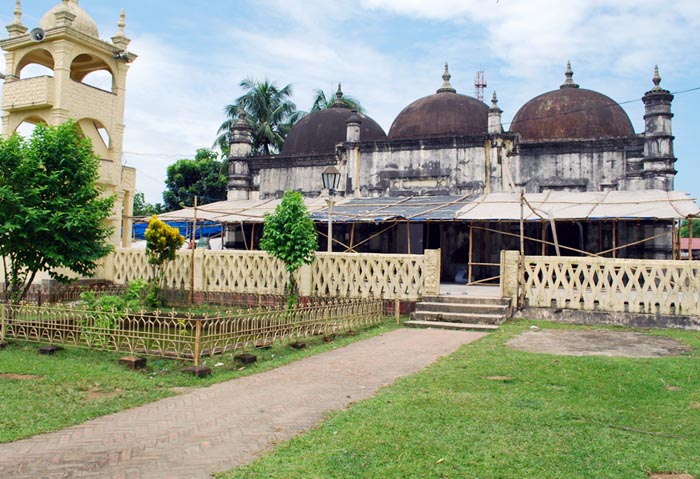Panbari Mosque

Information on Panbari Mosque (Dhubri, Assam) - History & Architecture
The popular historic Rangamati Masjid or Panbari Masjid is quite a well known mosque located in the north-eastern part of India and is regarded as one of the oldest mosques in Assam, India. The mosque is particularly located close to Rangamati and Panbari, both of which lies at a distance of about 25 kilometres from the small town of Dhubri. The mosque is also considered to be a classic instance of the excellent architectural accomplishments with regard to the Sultanate of Bengal.
Panbari Mosque Religious Significance
During the period when the Kochi rulers were in power, the area of Rangamati was then considered to be quite a thriving place. Rangamati was known to be used as a border post by the rulers of Kochi. The Rangamati fort was also used by the Mughals as well as the attacking army of the Bengal Sultans. The Muslim soldiers were employed to construct this particular mosque on the orders of Alauddin Husain Shah who was then the Sultan of Bengal between the period 1493 to 1519. After successfully taking into custody the Kamatpur kingdom, the Sultan announced to establish a mosque in the Panbari region in order to rejoice and commemorate the win and to proffer their gratitude in the form of prayers to the Islam spiritualist. The local people of Muslim origin were learnt to have discovered the Panbari mosque much later in a thick forest before about 200 years. The people from then on started offering their prayers or "Namaz" in the mosque. Presently, this particular mosque is acknowledged as the consecrated place for the Muslims of the western Assam. The mosque apart from being religiously important is also known to hold immense archaeological significance as recently, a township comprising terracotta antiques, brick pedestals along with a huge collection of coins from the medieval period were found close to the mosque. These archaeological specimens were learnt to have been possibly related to the period of Mughal rule.
Panbari Mosque Mythological Significance
According to the mythological records, it has been learnt that during the 16th century the present region of Panbari or Rangamati was a part of the Kamatpur kingdom which included certain regions of West Bengal, Assam and Meghalaya. The ruler during the concluding years of the 15th century, Nilambar was known to be a king with a violent character. His royal court included a man in the Manohar, who was Prime Minister Sachipatra's son and was comparatively young. Manohar and the queen both fell in love with each other without anyone's knowledge. King Nilambar came to know about the romantic affair between them and got Manohar killed with the help of secret assassins. However, Nilambar's rage did not end here and he chopped Manohar's body into several pieces which were served to Sachipatra during a royal feast which was held intentionally. Being filled with anger and sadness, Sachipatra invited Allaudin Hussain Shah, the Nawab of Goud to attack Kamatpur. The Nawab successfully conquered Kamatpur and in order to rejoice his success and to offer his gratitude he ordered the construction of a mosque and thus, the Panbari mosque was built.
Panbari Mosque Architectural Significance
As mentioned earlier the construction of the mosque took place between the period of 1493 to 1519 A.D by the famous administrator Alauddin Hussain Shah, the reigning Sultan of Bengal then. The mosque displays a typical Islamic pattern of architecture and has three domes. An "Idgah" or a deep well is located just next to the mosque which is stated to have been constructed at the same time. The mosque includes a huge courtyard along with a minaret which was probably constructed at a much later period. The mosque has a capacity to hold around 150 people at any given time.